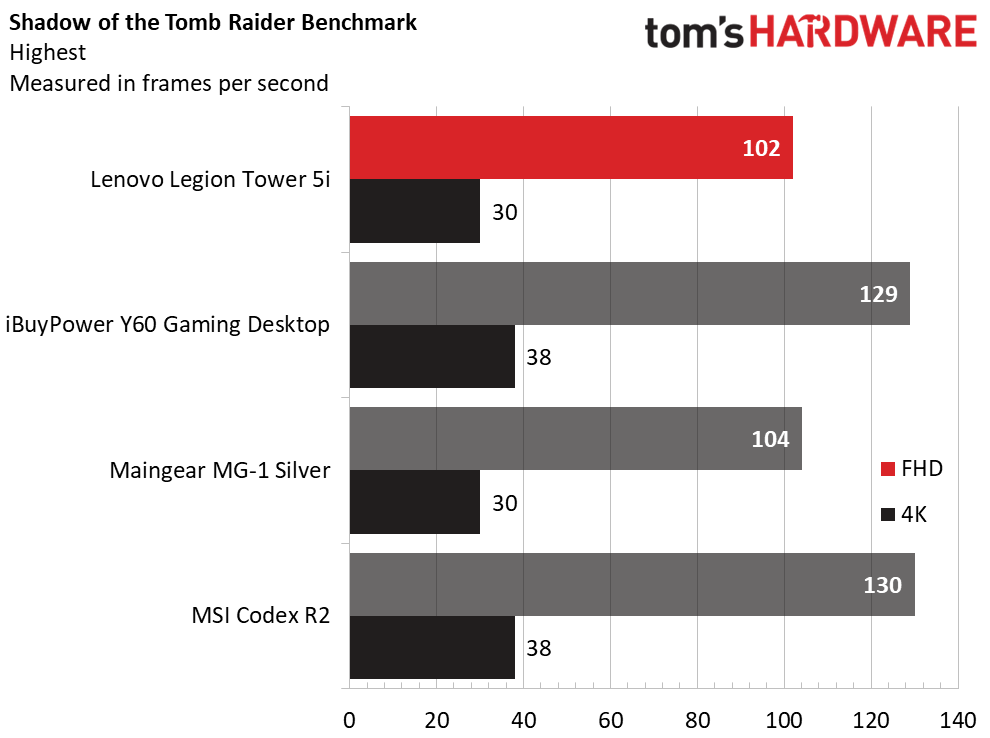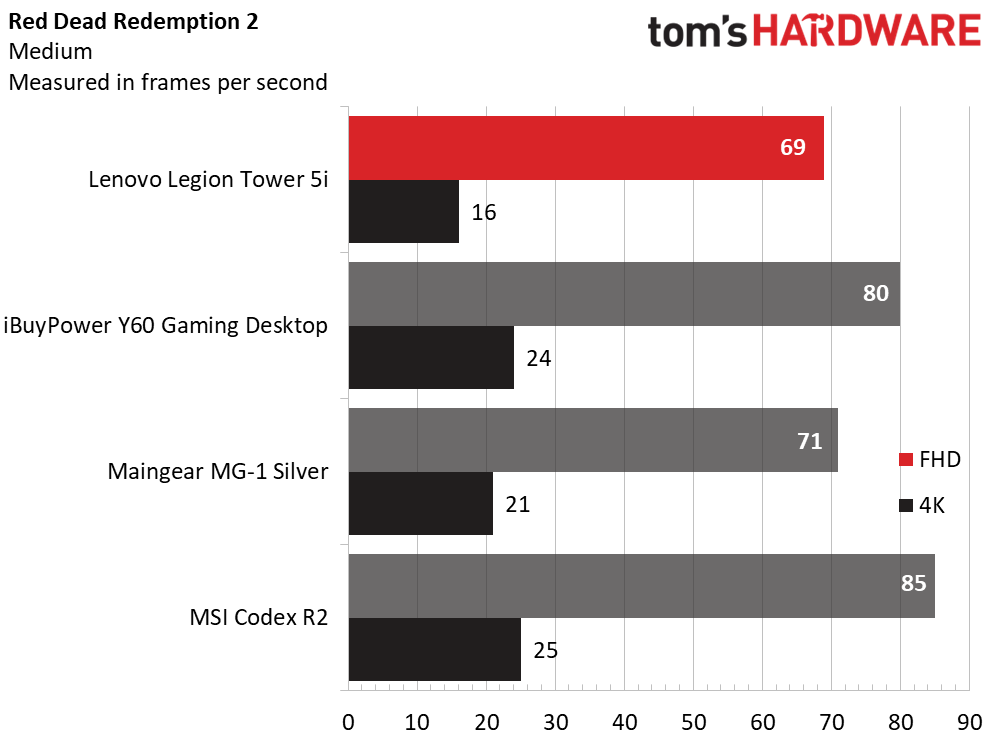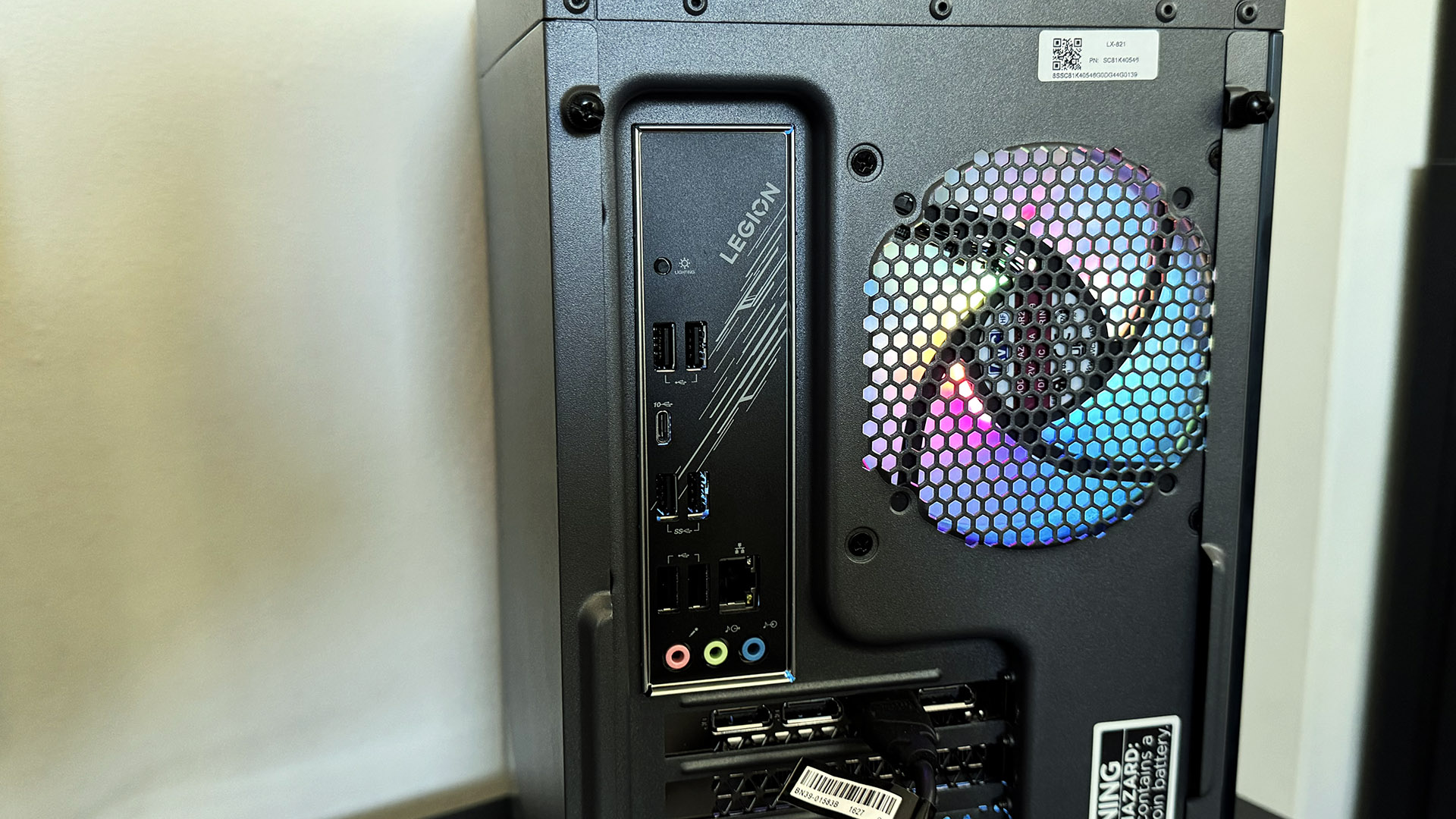Tom's Hardware Verdict
Lenovo’s Legion Tower 5i is a fantastic option for entry-level 1080p gaming, powered by a Core i5 CPU and GeForce RTX 4060. It also includes premium features, like a tempered glass case with customizable RGB lighting.
Pros
- +
Good 1080p performance for the money
- +
Quiet cooling and operation
- +
Solid build quality
- +
Customizable RGB lighting
Cons
- -
Lacks front USB Type-C port
- -
Cable management is a bit haphazard
Why you can trust Tom's Hardware
The best gaming desktops are ready to perform at their best straight out of the box, requiring no additional tweaking or upgrades. Lenovo’s Legion Tower 5i is a perfect example; while it's not fancy, it provides everything you need for 1080p gaming for $1,149.99. Equipped with a Core i5-14400F processor and a GeForce RTX 4060 graphics card, it can handle any modern game. We also noted its quiet fans and quality case with customizable RGB lighting. Although a front USB Type-C port would have been a welcome addition, this desktop excels everywhere else.
Lenovo Legion Tower 5i Gen 8 Specifications
CPU | Intel Core i5-14400F (6 Performance and 4 Efficient cores; 4.7GHz P-core Turbo Boost, 65W base power) |
Motherboard | Lenovo 3769 (Intel B660) |
Memory | 16GB DDR5-4800 (2x 8GB) |
Graphics | Nvidia GeForce RTX 4060 (8GB GDDR6, 2,460 MHz boost clock) |
Storage | 1TB SSD (Samsung MZVL21T0HDLU) |
Networking | Realtek Gaming 2.5GbE Ethernet, Wi-Fi 6E + Bluetooth 5.3 (Intel AX211) |
Front Ports | 2x USB 3.2 Gen 1 Type-A, 3.5 mm microphone, 3.5 mm microphone |
Rear Ports | USB 3.2 Gen 2 Type-C, 2x USB 3.2 Gen 1 Type-A, 4x USB 2.0, 3x 3.5 mm audio jacks (line-in, line-out, microphone) |
Power Supply | 500 watts |
Cooling | 80 mm air cooling |
Operating System | Windows 11 Home |
Dimensions (WxDxH) | 8.07 x 15.63 x 16.77 inches |
Price (as configured) | $1,149.99 |
Design of the Lenovo Legion Tower 5i Gen 8
The fans illuminate the interior nicely on their own, but there’s also a white LED lightstrip that ensures that there are no dark areas. The lighting can be configured in the included Lenovo Vantage app (More on that software later.)
Not all parts of the interior are worth illuminating; for instance, the low-profile aluminum CPU cooler and plain green DIMMs look very basic. The GeForce RTX 4060 is also quite short. At least there’s a Legion-branded heatspreader on the included M.2 SSD. I reduced the brightness of the LED lightstrip to let the RGB fans stand out more.
Measuring 8.07 x 15.63 x 16.77 inches, the Legion is slightly more compact than the Alienware Aurora R16, the MSI Codex R2 and the Maingear MG-1 Silver. Its build quality is good, made primarily of rolled steel and tempered glass. Four rubber feet under the desktop keep it from sliding around.
Ports and Upgradeability on the Lenovo Legion Tower 5i Gen 8
The Legion’s front ports, which are on top of the front panel, include two USB 3.2 Gen 1 Type-A ports, a 3.5 mm audio jack, and a 3.5 mm microphone jack. The power button is next to them. It would have been nice to have a USB Type-C port here, as more peripherals and storage drives are moving to the newer standard.
Ports on the motherboard backplane include five USB ports (one version 3.2 Gen 2 Type-C, two version 3.2 Gen 1 Type-A, and two 2.0), an Ethernet jack, and line-in, line-out, and microphone 3.5 mm audio jacks. A small button here lets you toggle between lighting profiles. For monitor output, the GeForce RTX 4060 has the expected arrangement consisting of one HDMI and three DisplayPorts.
The Legion’s side panels are each secured by two retainer-style thumbscrews.
Get Tom's Hardware's best news and in-depth reviews, straight to your inbox.
The Micro ATX motherboard offers four DDR5 DIMM slots, two M.2 2280 PCI Express slots for storage drives (one above the GPU and one accessible after removing the GPU), and an M.2 2230 slot for the wireless card, which provides Wi-Fi 6E and Bluetooth 5.3. The SSD installed in our unit has its own heatsink. For expansion cards, one PCI Express x4 slot is available below the GPU.
Removing the right-side panel provides access to the two 3.5-inch toolless drive bays, which conveniently have both power and SATA cables run to them.
The 500-watt power supply isn’t modular (not that we expect it to be at this price) and the cable management is a bit haphazard. The PSU has six- and eight-pin GPU power connectors for future GPU upgrades.
Overall, this Legion has impressive upgradeability since it uses all standardized parts that can be replaced in the aftermarket. The same can’t be said about the Alienware Aurora R16.
Gaming and Graphics on the Lenovo Legion Tower 5i Gen 8
Our Legion review unit has an Intel Core i5-14400F processor, an Nvidia GeForce RTX 4060 graphics card, and 16GB of DDR5 RAM. It’s a solid 1080p gaming platform.
Playing Rise of the Tomb Raider at 3840 x 2160 with Very High settings, I saw a constant 60 frames per second (fps) with V-Sync enabled and only occasional dips into the mid-50 fps range while playing the Geothermal Valley level. It was highly playable, and I didn’t experience any stuttering.





In Shadow of the Tomb Raider, both the Legion and Maingear systems delivered similar performance, reaching just over 100 fps at 1080p but only 30 fps at 4K. On the other hand, the RTX 4060 Ti-powered iBuyPower and MSI systems performed significantly better, achieving 129-130 fps at 1080p and both scoring 38 fps at 4K.
In Cyberpunk 2077, the Legion managed only 33 fps at 1080p and a mere 6 fps at 4K. The iBuyPower and MSI performed better, with 46-47 fps at 1080p and 6-7 fps at 4K. (We don’t have performance data for the Maingear in this game.)
In Far Cry 6, the Legion and Maingear systems maintained similar performance, with the Legion reaching 89 fps at 1080p and 39 fps at 4K, compared to the Maingear’s 91 fps and 38 fps. As anticipated, the iBuyPower and MSI towers, equipped with the RTX 4060 Ti, delivered significantly better results.
Last, in Borderlands 3, the Legion fell behind the Maingear at 1080p, hitting 85 fps versus 104 fps. The iBuyPower and MSI systems performed much better, both reaching 115 fps.
The Legion’s performance overall meets expectations for its RTX 4060, which pairs well with the Core i5-14400F. It’s well-suited for 1080p gaming but is not intended for 4K gaming. The same limitations apply to the RTX 4060 Ti.
We stress test gaming desktops by running the Metro Exodus benchmark 15 times at RTX settings, simulating half an hour of gaming. During the test, the Legion averaged 70.47 fps across all runs, with only minor variance in frame rate, indicating very stable thermal performance. The Core i5’s P-cores ran at an average frequency of 3.95 GHz and an average temperature of 59 degrees C, while the E-cores averaged 2.88 GHz and 57 C. The GeForce RTX 4060 maintained an average clock speed of 2.31 GHz and temperature of 64 C. Throughout testing, the system’s fans were barely noticeable, with no audible RPM variance.
Productivity Performance on the Lenovo Legion Tower 5i Gen 8
Our Legion review unit has a Core i5-14400F processor, 16GB of RAM, and a 1TB SSD.



In the cross-platform Geekbench 6 benchmark, the Legion scored 2,362 points in the single-core test, just edging out the Maingear’s 2,330 points. However, the Legion leaped ahead in multi-core, achieving 11,791 points compared to the Maingear’s 9,743 points. The iBuyPower, equipped with the Ryzen 7 7700X, had the highest single-core score of 2,991 points while the MSI, with its Core i7-14700F, led in the multi-core test with 17,818 points.
The Legion delivered the best performance in our 25GB file transfer test, with 1,530.94 MBps. The iBuyPower followed with 1,327.99 MBps. The MSI trailed significantly, at 977.94 MBps, while the Maingear had a dismal showing of 489.65 MBps.
In our Handbrake file transcoding test, where we transcode a 4K video to 1080p, the Legion recorded the slowest time of 5 minutes and 38 seconds while the Maingear was slightly quicker at 5 minutes and 24 seconds. As expected, both the iBuyPower and MSI systems finished with much faster times, completing the test around 3 minutes and 30 seconds.
Keyboard and Mouse with the Lenovo Legion Tower 5i Gen 8
The basic wired peripherals that come with the Legion are functional if you have nothing else. The keyboard features laptop-style keys with limited travel and an unexciting feel. It's effectively an office keyboard. It lacks special features, backlighting, and extra ports. In short, it’s just a keyboard, and a far cry from anything in our best keyboards list.
The mouse is equally basic, with two buttons and a scroll wheel. Its optical sensor tracked accurately on both my mousepad and a wooden tabletop. The ambidextrous shape fit my medium-size hands. Check out our best gaming mice for something more engaging.
Software and Warranty on the Lenovo Legion Tower 5i Gen 8
The Lenovo Vantage app shows system health and provides system updates. It also offers GPU overclocking, though it’s limited to just core and VRAM clock offsets. Its primary feature is lighting control, allowing you to manage the Legion’s four lighting zones (the Legion logo, two front fans, rear fan, and LED strip) across three profiles. The case fans and logo support various patterns, including static, flicker, breathe, wave, spectrum, CPU temperature, rainbow, and random, with adjustable speed and brightness. The LED strip supports a breathing pattern and has adjustable brightness and speed.
Legion Arena is another notable included app, which provides a single place to access all your games. It can connect to services including Steam, Epic, Battle.net, Xbox, and Ubisoft.
The other included app is Nahimic for audio EQ settings. Otherwise, the Legion is essentially free of unwanted software.
The Legion comes with a one-year warranty.
Lenovo Legion Tower 5i Gen 8 Configurations
The Legion Tower 5i Gen 8 base model, discounted to $908.99 at review time, features a Core i5-14400F, a GeForce RTX 4060, 16GB of RAM, and a 512GB SSD. Our $1,149.99 review model stepped up to a 1TB SSD and wasn’t discounted at review time.
Lenovo also offers step-up models with a Core i7-14700F processor, 32GB of RAM, and a GeForce RTX 4070 Super or GeForce RTX 4070 Ti Super starting at $1,989.99. The Core i7 models include a larger 150W CPU air cooler with a 120 mm RGB fan.
Lenovo has priced the Legion Tower 5i competitively. At the time of review, other RTX 4060 desktops included the MSI Codex R2, discounted to $999 on Newegg with 32GB of RAM and a 2TB SSD, and a Core i7-14700F version for $1,059. The Maingear MG-1 Silver was more expensive at $1,249 with a Ryzen 5 7600X. Additionally, the Alienware Aurora R16 was listed at $1,299.99 with a Core i7-14700F and 32GB of RAM.
Bottom Line
Lenovo’s Legion Tower 5i is a solid value for gamers seeking a budget-friendly desktop. Equipped with a Core i5-14400F and a GeForce RTX 4060, it delivers competent 1080p performance. We were also impressed by its case, quiet RGB fans, aftermarket upgradeability, and extensive lighting controls.
Next to the competition, the Legion Tower 5i provides better value than the Alienware Aurora R16 and features standardized parts for superior upgradeability, is quieter than the MSI Codex R2, and is less expensive than the Maingear MG-1. That made the Legion Tower 5i impressive for the price if you're looking to buy your budget gaming PC pre-built.

Charles Jefferies is a freelance reviewer for Tom’s Hardware US. He covers laptop and desktop PCs, especially gaming models.








